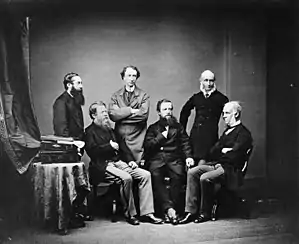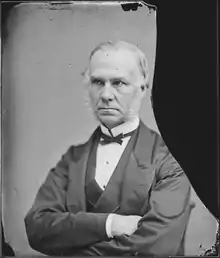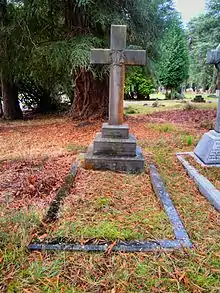Edward Thornton, 2nd Count of Cacilhas
Sir Edward Thornton GCB (13 July 1817 – 26 January 1906) was a British diplomat, who held posts in Latin America, Turkey, Russia, and served for fourteen years as Minister to the United States.[1]


Early career
Thornton was born in London, the son of Sir Edward Thornton, 1st Count of Cacilhas, also a diplomat, who for many years held the post of British Minister to Portugal.[1]

On his father's death, Thornton became 2nd Count of Cacilhas (also "Cassilhas").[2]
Thornton was educated at King's College London, and at Pembroke College, Cambridge.[1][3][4] He entered the diplomatic service as attaché to the mission at Turin in 1842, filled the same position in Mexico in 1845, and was made Secretary of Legation in that Capital in 1853.[1][4] Thornton did much to forward the conclusion of the Treaty of Guadalupe Hidalgo in 1848. In 1852, he was appointed Secretary of Legation at Buenos Aires, and chargé d'affaires to Uruguay in 1854.[4] He was appointed Minister to the Argentine Republic in 1859, and to Brazil in 1865.[1][4]
Paraguay
In November 1859, Thornton ordered the Royal Navy to attack the Paraguyan war steamer Tacuari, which future president Francisco Solano López was on, to pressure his father President Carlos López to release a British citizen from prison.[5] This was one of several incidents that damaged Paraguayan relations with Britain. Thornton would later apologise for the action to repair relations, and promised Britain had no intention of interfering with Paraguayan jurisdiction. His actions were used in a House of Commons debate on a potential war with Brazil, with William "Seymour" Vesey-FitzGerald calling him "a gentleman who knows how to conciliate... that it is not his duty to "read lessons" to foreign Governments" as an attack on Brazilian consul William Dougal Christie, while opposing MP Layard pointed to Thornton as proof that Britain did not take a "high hand" with Latin American nations. At the time, there was a belief that Latin American states were constantly embroiled in tensions and would cause strife for foreign governments.[6]
After the war scare with Brazil was averted, another major geopolitical conflict embroiled Latin America- the Paraguayan War. Brazil, Argentina and Uruguay signed the Treaty of the Triple Alliance, which united all three nations against Paraguay.[7] According to American historian Pelham H. Box, Argentine foreign minister Rufino de Elizalde informed Thornton the Argentine government had no wish to annex Paraguay, but hoped that in the long term Paraguay might voluntarily join the Argentine Confederation (as was contemplated by Article 13 of the Argentine Constitution). He also informed Thornton that the Argentine Congress feared the provisions in the Treaty might prevent such an occurrence.[8] After the war concluded, Thornton was withdrawn from his position, having concluded several agreements during his tenure.[9][10]
Minister to the United States

Thornton's lengthiest assignment was as Minister to the United States, a position he held for fourteen years (1867–1881).[1]
In 1871, Thornton served as a member of the commission on the Alabama Claims, and was appointed Privy Councilor.[1] Thornton served in 1873 as an arbitrator in the commission on the Mexican and United States Claims.[1][4] He was appointed Ambassador at St. Petersburg in 1881.[1][4] For his services Thornton was invested Knight Grand Cross of the Order of the Bath in 1883.[1][4] A year later Thornton received his last appointment, Ambassador at Constantinople, a position he held for three years before retiring.[1][4]
Thornton died at his London residence, 5 Tedworth Sq., after what was described as a lengthy illness.[1] He is buried in Brookwood Cemetery. As his son and heir, diplomat Edward Thornton (born 1856), had died in 1904, the title of Count of Cacilhas passed to his grandson, Edward Thornton.[2]
References
- "Death List of a Day. Sir Edward Thornton." The New York Times, 27 January 1906. Pg. 9. Accessed: 18 July 2009.
- Burke's Great War Peerage, Burke's Peerage and Gentry (UK) Ltd, 2008 [a reprint of A Genealogical and Heraldic History of the Peerage and Baronetage, 76th edition, ed. Ashworth P. Burke, Harrison & Sons, 1914], p. 2112
- "Thornton, Edward (THNN834E)". A Cambridge Alumni Database. University of Cambridge.
- Henry Robert Addison, Charles Henry Oakes, William John Lawson, Douglas Brooke Wheelton Sladen, ed. Who's Who: An Annual Biographical Dictionary, Page 1617 – London: Adam and Charles Black, 1904
- TRATADO DE LAS PUNTAS DEL ROSARIO (Guerra del Paraguay) (in Spanish)
- Commons Sitting – BRAZIL.—PAPER MOVED FOR −887 Hansard 16 July 1863
- Lettsom to Earl Russell (1866). "Treaty of Alliance against Paraguay". Accounts and Papers of the House of Commons: Thirty-Nine Volumes: Session 1 February — 10 August 1866. 76. House of Commons. pp. 79–83. Retrieved 23 November 2019.CS1 maint: ref=harv (link)
- Box, Pelham Horton (1930). The Origins of the Paraguayan War. Urbana, IL: University of Illinois Studies in the Social Sciences.CS1 maint: ref=harv (link)
- Katra, William H. The Argentine Generation of 1837: Echeverria, Alberdi, Sarmiento, Mitre, page 261. Fairleigh Dickinson University Press, 1996
- Historia General de las relaciones internacionales de la República Argentina (in Spanish)
| Diplomatic posts | ||
|---|---|---|
| Preceded by Sir Frederick Bruce |
British Minister to the United States 1867–1881 |
Succeeded by Lionel Sackville-West |
This article incorporates text from a publication now in the public domain: Gilman, D. C.; Peck, H. T.; Colby, F. M., eds. (1905). New International Encyclopedia (1st ed.). New York: Dodd, Mead. Missing or empty |title= (help)
External links
| Wikimedia Commons has media related to Edward Thornton (diplomat). |
- Sir Edward Thornton Correspondence with the British Foreign Office. General Collection, Beinecke Rare Book and Manuscript Library, Yale University.